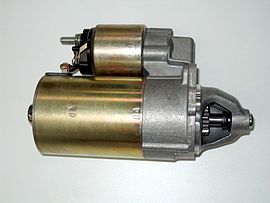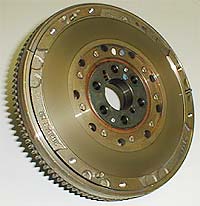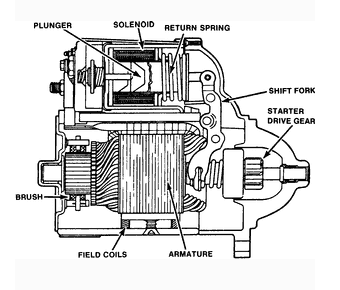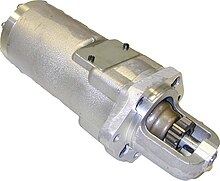Starter (engine)

A starter (also self-starter, cranking motor, or starter motor) is a device used to rotate (crank) an
Internal combustion engines are feedback systems, which, once started, rely on the inertia from each cycle to initiate the next cycle. In a four-stroke engine, the third stroke releases energy from the fuel, powering the fourth (exhaust) stroke and also the first two (intake, compression) strokes of the next cycle, as well as powering the engine's external load. To start the first cycle at the beginning of any particular session, the first two strokes must be powered in some other way than from the engine itself. The starter motor is used for this purpose and it is not required once the engine starts running and its feedback loop becomes self-sustaining.

History


Before the advent of the starter motor, engines were started by various methods including wind-up springs, gunpowder cylinders, and human-powered techniques such as a removable crank handle which engaged the front of the crankshaft, pulling on an airplane propeller, or pulling a cord that was wound around an open-face pulley.
The hand-crank method was commonly used to start engines, but it was inconvenient, difficult, and dangerous. The behavior of an engine during starting is not always predictable. The engine can kick back, causing sudden reverse rotation. Many manual starters included a one-directional slip or release provision so that once engine rotation began, the starter would disengage from the engine. In the event of a kickback, the reverse rotation of the engine could suddenly engage the starter, causing the crank to unexpectedly and violently jerk, possibly injuring the operator. For cord-wound starters, a kickback could pull the operator towards the engine or machine, or swing the starter cord and handle at high speed around the starter pulley. Even though cranks had an overrun mechanism, when the engine started, the crank could begin to spin along with the crankshaft and potentially strike the person cranking the engine. Additionally, care had to be taken to retard the spark in order to prevent backfiring; with an advanced spark setting, the engine could kick back (run in reverse), pulling the crank with it, because the overrun safety mechanism works in one direction only.
Although users were advised to cup their fingers and thumb under the crank and pull up, it felt natural for operators to grasp the handle with the fingers on one side, the thumb on the other. Even a simple backfire could result in a broken thumb; it was possible to end up with a
The first electric starter was installed on an Arnold, an adaptation of the Benz Velo, built in 1896 in East Peckham, England, by electrical engineer H. J. Dowsing.[2]
In 1903, Clyde J. Coleman invented and patented the first electric starter in America U.S. patent 0,745,157.[3]
In 1911,
One aspect of the invention lay in the realization that a relatively small motor, driven with higher voltage and current than would be feasible for continuous operation, could deliver enough power to crank the engine for starting. At the voltage and current levels required, such a motor would burn out in a few minutes of continuous operation, but not during the few seconds needed to start the engine. The starters were first installed on the
Although the electric starter motor was to come to dominate the car market, in 1912, there were several competing types of starter,
One of the innovations on the first Dodge car, the Model 30-35 at its introduction in 1914 was an electric starter and electric lighting with a 12-volt system (against the six volts that was usual at the time) as a standard fitment on what was a relatively low-priced car. The Dodge used a combined starter-generator unit, with a direct current dynamo permanently coupled by gears to the engine's crankshaft. A system of electrical relays allowed this to be driven as a motor to rotate the engine for starting, and once the starter button was released the controlling switchgear returned the unit to operation as a generator. Because the starter-generator was directly coupled to the engine it did not need a method of engaging and disengaging the motor drive. It thus suffered negligible mechanical wear and was virtually silent in operation. The starter-generator remained a feature of Dodge cars until 1929. The disadvantage of the design was that, as a dual-purpose device, the unit was limited in both its power as a motor and its output as a generator, which became a problem as engine size and electrical demands on cars increased. Controlling the switch between motor and generator modes required dedicated and relatively complex switchgear which was more prone to failure than the heavy-duty contacts of a dedicated starter motor. While the starter-generator dropped out of favour for cars by the 1930s, the concept was still useful for smaller vehicles and was taken up by the German firm SIBA Elektrik which built similar system intended mostly for use on motorcycles, scooters, economy cars (especially those will small-capacity two-stroke engines), and marine engines. These were marketed under the 'Dynastart' name. Since motorcycles usually had small engines and limited electrical equipment, as well as restricted space and weight, the Dynastart was a useful feature. The windings for the starter-generator were usually incorporated into the engine's flywheel, thus not requiring a separate unit at all.
The Ford Model T relied on hand cranks until 1919; during the 1920s, electric starters became near-universal on most new cars, making it easier for women and elderly people to drive. It was still common for cars to be supplied with starter handles into the 1960s, and this continued much later for some makes (e.g. Citroën 2CV until end of production in 1990). In many cases, cranks were used for setting timing rather than starting the engine as growing displacements and compression ratios made this impractical. Communist bloc cars such as Ladas often still sported crank-starting as late as the 1980s.
For the first examples of production German turbojet engines later in World War II, Norbert Riedel designed a small two-stroke, opposed-twin gasoline engine to start both the Junkers Jumo 004 and BMW 003 aircraft gas turbines as a form of auxiliary power unit to get the central spindle of each engine design rotating — these were usually installed at the very front of the turbojet, and were themselves started by a pull-rope to get them running during the startup procedure for the jet engines they were fitted to.
Before Chrysler's 1949 innovation of the key-operated combination ignition-starter switch,[5] the starter was often operated by the driver pressing a button mounted on the floor or dashboard. Some vehicles had a pedal in the floor that manually engaged the starter drive pinion with the flywheel ring gear, then completed the electrical circuit to the starter motor once the pedal reached the end of its travel. Ferguson tractors from the 1940s, including the Ferguson TE20, had an extra position on the gear lever that engaged the starter switch, ensuring safety by preventing the tractors from being started in gear.[6]
Electric

The electric starter motor or cranking motor is the most common type used on gasoline engines and small diesel engines. The modern starter motor is either a permanent-magnet or a
The solenoid also closes high-current contacts for the starter motor, which begins to turn. Once the engine starts, the key-operated switch is opened, a spring in the solenoid assembly pulls the pinion gear away from the ring gear, and the starter motor stops. The starter's pinion is clutched to its drive shaft through an overrunning sprag clutch which permits the pinion to transmit drive in only one direction. In this manner, drive is transmitted through the pinion to the flywheel ring gear, but if the pinion remains engaged (as for example because the operator fails to release the key as soon as the engine starts, or if there is a short and the solenoid remains engaged), the pinion will spin independently of its drive shaft. This prevents the engine driving the starter, for such backdrive would cause the starter to spin so fast as to fly apart.
The sprag clutch arrangement would preclude the use of the starter as a generator if employed in the hybrid scheme mentioned above, unless modifications were made. The standard starter motor is typically designed for intermittent use, which would preclude its use as a generator. The starter's electrical components are designed only to operate for typically under 30 seconds before overheating (by too-slow dissipation of heat from ohmic losses), to save weight and cost. Most automobile owner manuals instruct the operator to pause for at least ten seconds after each ten or fifteen seconds of cranking the engine, when trying to start an engine that does not start immediately.
This overrunning-clutch pinion arrangement was phased into use beginning in the early 1960s; before that time, a Bendix drive was used. The Bendix system places the starter drive pinion on a helically cut drive shaft. When the starter motor begins turning, the inertia of the drive pinion assembly causes it to ride forward on the helix and thus engage with the ring gear. When the engine starts, backdrive from the ring gear causes the drive pinion to exceed the rotative speed of the starter, at which point the drive pinion is forced back down the helical shaft and thus out of mesh with the ring gear.[8] This has the disadvantage that the gears will disengage if the engine fires briefly but does not continue to run.
Folo-Thru drive
An intermediate development between the Bendix drive developed in the 1930s and the overrunning-clutch designs introduced in the 1960s was the Bendix Folo-Thru drive. The standard Bendix drive would disengage from the ring gear as soon as the engine fired, even if it did not continue to run. The Folo-Thru drive contains a latching mechanism and a set of flyweights in the body of the drive unit. When the starter motor begins turning and the drive unit is forced forward on the helical shaft by inertia, it is latched into the engaged position. Only once the drive unit is spun at a speed higher than that attained by the starter motor itself (i.e., it is backdriven by the running engine) will the flyweights pull radially outward, releasing the latch and permitting the overdriven drive unit to be spun out of engagement. In this manner, unwanted starter disengagement is avoided before a successful engine start.
Gear reduction
In 1962,
The Chrysler gear-reduction starter formed the conceptual basis for the gear-reduction starters that now predominate in vehicles on the road. Many Japanese automakers phased in gear reduction starters in the 1970s and 1980s.[citation needed] Light aircraft engines also made extensive use of this kind of starter, because its light weight offered an advantage.
Those starters not employing offset gear trains like the Chrysler unit generally employ planetary epicyclic gear trains instead. Direct-drive starters are almost entirely obsolete owing to their larger size, heavier weight and higher current requirements.[citation needed]
Movable pole shoe
This starter was used on Ford vehicles from 1973 through 1990, when a gear-reduction unit conceptually similar to the Chrysler unit replaced it.
Inertia starter
A variant on the electric starter motor is the inertia starter (not to be confused with the Bendix-type starter described above). Here the starter motor does not turn the engine directly. Instead, when energized, the motor turns a heavy flywheel built into its casing (not the main flywheel of the engine). Once the flywheel/motor unit has reached a constant speed the current to the motor is turned off and the drive between the motor and flywheel is disengaged by a freewheel mechanism. The spinning flywheel is then connected to the main engine and its inertia turns it over to start it. These stages are commonly automated by solenoid switches, with the machine operator using a two-position control switch, which is held in one position to spin the motor and then moved to the other to cut the current to the motor and engage the flywheel to the engine.
The advantage of the inertia starter is that, because the motor is not driving the engine directly, it can be of much lower power than the standard starter for an engine of the same size. This allows for a motor of much lower weight and smaller size, as well as lighter cables and smaller batteries to power the motor. This made the inertia starter a common choice for aircraft with large radial piston engines. The disadvantage is the increased time required to start the engine - spinning up the flywheel to the required speed can take between 10 and 20 seconds. If the engine does not start by the time the flywheel has lost its inertia then the process must be repeated for the next attempt.
Pneumatic
Some
Aircraft with large gas turbine engines are typically started using a large volume of low-pressure compressed air, supplied from a very small engine referred to as an auxiliary power unit, located elsewhere in the aircraft. Alternatively, aircraft gas turbine engines can be rapidly started using a mobile ground-based pneumatic starting engine, referred to as a start cart or air start cart.
On larger diesel generators found in large shore installations and especially on ships, a pneumatic starting gear is used. The air motor is normally powered by compressed air at pressures of 10–30 bar. The air motor is made up of a center drum about the size of a soup can with four or more slots cut into it to allow for the vanes to be placed radially on the drum to form chambers around the drum. The drum is offset inside a round casing so that the inlet air for starting is admitted at the area where the drum and vanes form a small chamber compared to the others. The compressed air can only expand by rotating the drum, which allows the small chamber to become larger and puts another one of the cambers in the air inlet. The air motor spins much too fast to be used directly on the flywheel of the engine; instead a large gearing reduction, such as a planetary gear, is used to lower the output speed. A Bendix gear is used to engage the flywheel.
Since large trucks typically use air brakes, the system does double duty, supplying compressed air to the brake system. Pneumatic starters have the advantages of delivering high torque, mechanical simplicity and reliability. They eliminate the need for oversized,[quantify] heavy storage batteries in prime mover electrical systems.
Large Diesel generators and almost all Diesel engines used as the prime mover of ships use compressed air acting directly on the cylinder head. This is not ideal for smaller Diesels, as it provides too much cooling on starting. Also, the cylinder head needs to have enough space to support an extra valve for the air start system. The air start system is conceptually very similar to a distributor in a car. There is an air distributor that is geared to the camshaft of the Diesel engine; on the top of the air distributor is a single lobe similar to what is found on a camshaft. Arranged radially around this lobe are roller tip followers for every cylinder. When the lobe of the air distributor hits one of the followers it will send an air signal that acts upon the back of the air start valve located in the cylinder head, causing it to open. Compressed air is provided from a large reservoir that feeds into a header located along the engine. As soon as the air start valve is opened, the compressed air is admitted and the engine will begin turning. It can be used on two-cycle and four-cycle engines and on reversing engines. On large two-stroke engines less than one revolution of the crankshaft is needed for starting.
Hydraulic

Some
With various configurations, Hydraulic starters can be fitted on any engine. Hydraulic starters employ the high efficiency of the axial piston motor concept, which provides high torque at any temperature or environment, and guarantees minimal wear of the engine ring gear and the pinion.[12]
Non-motor
Spring starter

A spring starter uses
Fuel-starting
Some modern gasoline engines with twelve or more cylinders always have at least one or more pistons at the beginning of its power stroke and are able to start by injecting fuel into that cylinder and igniting it. The same procedure can be applied to engines with fewer cylinders, if the engine happens to be stopped at the correct position. This is one way of starting an engine of a car with
See also
- Aircraft engine starter
- Coffman starter
- Flame-start system
- Hucks starter
- Hybrid Synergy Drive
- List of auto parts
- Vincent Hugo Bendix
References
- ^ Gingell, Rachel (8 December 2016). "The John Deere 720 diesel and its innovative pony motor design". Farms.com. Retrieved 28 March 2021.
- ISBN 9781855019263.
- ^ "Patent No 745 157" (PDF).
- ^ a b "Olympia Motor Show". The Automotor Journal: 1402–1412. 23 November 1912.
- ^ Whittacker, Wayne (April 1949). "Chrysler Family Debut". Popular Mechanics. 91 (4): 122. Retrieved 25 May 2015.
- ISBN 9780896582804. Retrieved 25 May 2015.
- ^ R. Howell, Benito (17 August 2017). "Permanent Magnet Generators for Diesel Engines". PM Generators. Retrieved 14 January 2021.
- ^ "Know Your Car's Nervous System - Starters". Popular Mechanics. 96 (6): 186–189. June 1952. Retrieved 25 May 2015.
- ^ The 1962 Starting Motor and Alternator, Chrysler Corporation, November 1961
- ^ LaChance, David (June 2007). "Memorable Mirada". Hemmings Classic Car. Retrieved 25 May 2015.
...the twitterings of the Highland Park hummingbird, Mopar's famous gear-reduction starter...
- ^ "Engine and turbine starters" (PDF). Fspowercontrol.com. Archived from the original (PDF) on 30 May 2013.
- ^ "Hydraulic Starting Systems". Huegli-tech.com. Retrieved 25 May 2015.
- ^ 1963 Briggs Wind-up Starter. YouTube.
- ^ "Idling Stop Technology". Mazda.com. Retrieved 30 November 2015.
External links
Patents
- U.S. patent 745,157, Clyde J. Coleman
- U.S. patent 1,050,739, R. C. Hull
- U.S. patent 1,464,714, Arthur Atwater Kent

